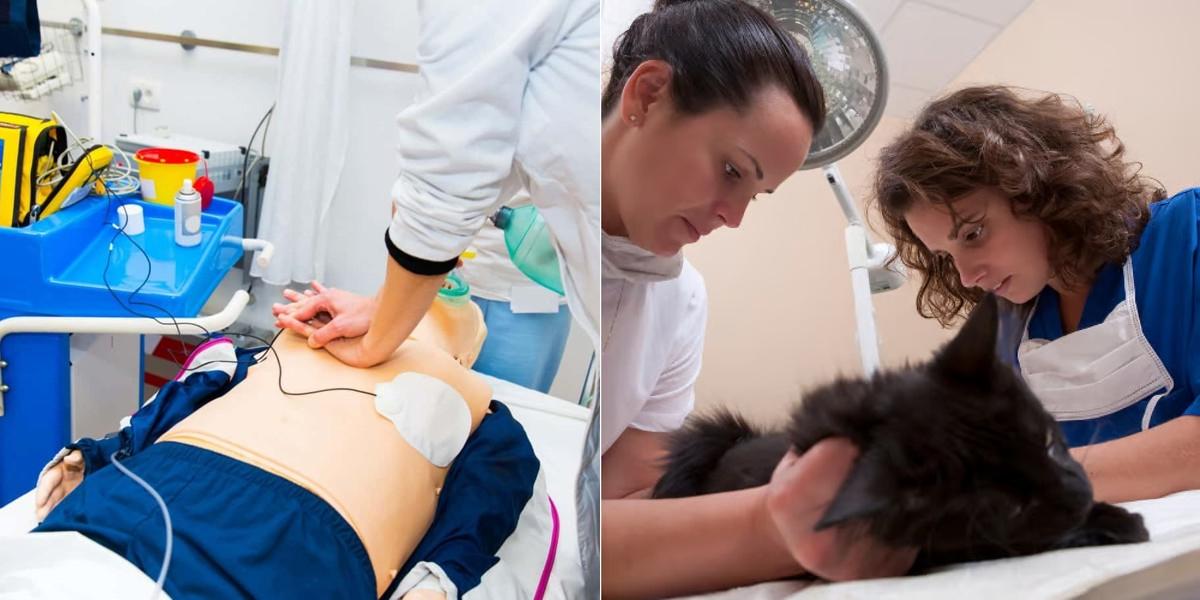ACLS vs Veterinary Assistant

Want personalized recommendations?
Let's match you to the right program

Are you considering a career in healthcare but not sure which path to take? Two options to consider are becoming an ACLS (Advanced Cardiovascular Life Support) provider or a veterinary assistant. While both career paths involve working with patients, there are some key differences to consider. In this blog post, we will explore what each role entails, the education and training required, and the career outlook and salary potential for each profession.
Article continues after recommendations
Recommended for you
Introduction
In the healthcare field, there are a wide variety of career paths to choose from. Whether you are interested in working directly with patients or behind the scenes, there is a role that is right for you. Two options to consider are becoming an ACLS provider or a veterinary assistant. Both roles involve providing care to patients, but in very different settings. Let's explore what each role entails and how they differ from one another.
What is an ACLS and Veterinary Assistant?
Before we dive into the differences between an ACLS provider and a veterinary assistant, let's first define what each role entails.
-
ACLS Provider: An ACLS provider is a healthcare professional who is trained in advanced cardiovascular life support. They are responsible for responding to cardiac emergencies and providing life-saving interventions such as CPR, defibrillation, and advanced airway management. ACLS providers work in a variety of healthcare settings, including hospitals, emergency rooms, and ambulatory care centers.
-
Veterinary Assistant: A veterinary assistant is a healthcare professional who provides support to veterinarians and veterinary technicians in animal clinics and hospitals. They are responsible for a variety of tasks, including assisting with examinations and procedures, administering medications, and providing basic care to animals. Veterinary assistants work primarily in veterinary clinics, animal hospitals, and research facilities.
Difference between an ACLS and Veterinary Assistant
While both an ACLS provider and a veterinary assistant are healthcare professionals who provide care to patients, there are some key differences between the two roles:
-
Patient Population: ACLS providers primarily work with human patients, while veterinary assistants work with animals.
-
Scope of Practice: ACLS providers are trained to respond to cardiac emergencies and provide advanced life support interventions. Veterinary assistants, on the other hand, are responsible for providing basic care to animals and supporting veterinarians and veterinary technicians in their work.
-
Work Environment: ACLS providers typically work in hospitals, emergency rooms, and other healthcare settings. Veterinary assistants, on the other hand, work in veterinary clinics, animal hospitals, and research facilities.
-
Training and Education: ACLS providers are typically healthcare professionals, such as doctors, nurses, or paramedics, who have completed additional training in advanced cardiovascular life support. Veterinary assistants can enter the field with a high school diploma or equivalent, although some choose to pursue vocational training or a degree in veterinary technology.
ACLS vs Veterinary Assistant: Job Description
Now that we have a better understanding of what each role entails, let's take a closer look at the job description for both an ACLS provider and a veterinary assistant.
-
ACLS Provider: As an ACLS provider, your primary role is to respond to cardiac emergencies and provide life-saving interventions. This may include performing CPR, administering medications, and using advanced airway management techniques. ACLS providers work closely with other healthcare professionals, such as doctors and nurses, to provide timely and effective care to patients in need.
-
Veterinary Assistant: As a veterinary assistant, your job is to provide support to veterinarians and veterinary technicians in the care of animals. This may include assisting with examinations and procedures, administering medications, and providing basic care to animals. Veterinary assistants also play a crucial role in educating pet owners about proper animal care and assisting with client communication.
Get courses selected just for you
Try our powerful search engine
Article continues after recommendations
More recommendations for you
ACLS vs Veterinary Assistant: Education and Training
The education and training required to become an ACLS provider or a veterinary assistant differ significantly. Let's take a closer look at the requirements for each profession:
-
ACLS Provider: To become an ACLS provider, you must first be a healthcare professional, such as a doctor, nurse, or paramedic. Once you have completed your initial healthcare training, you can then pursue additional ACLS certification. This typically involves completing a specialized training course and passing a certification exam.
-
Veterinary Assistant: The education and training requirements for veterinary assistants vary. While some veterinary assistants enter the field with a high school diploma or equivalent, others choose to pursue vocational training or a degree in veterinary technology. These programs typically cover topics such as animal anatomy and physiology, veterinary pharmacology, and veterinary office procedures.
ACLS vs Veterinary Assistant: Career Outlook and Salary
When considering a career path, it is important to consider the career outlook and salary potential for each profession. Let's take a closer look at the career outlook and salary for ACLS providers and veterinary assistants:
-
ACLS Provider: The demand for ACLS providers is expected to remain strong in the coming years, as the need for advanced cardiac care continues to grow. According to the Bureau of Labor Statistics, the median annual wage for healthcare practitioners and technical occupations, which includes ACLS providers, was $69,870 in May 2020.
-
Veterinary Assistant: The demand for veterinary assistants is also expected to grow in the coming years, as more pet owners seek healthcare for their animals. According to the Bureau of Labor Statistics, the median annual wage for veterinary assistants was $28,590 in May 2020.
Final Thoughts
Choosing a career path can be a challenging decision, but by considering your interests, skills, and goals, you can find a profession that is right for you. Whether you are interested in providing advanced cardiac care as an ACLS provider or supporting veterinarians as a veterinary assistant, both roles offer rewarding opportunities to make a difference in the lives of patients, whether they are human or animal.
Dreambound's educational programs open doors to exciting opportunities. For a more comprehensive understanding of the potential within these two vocations, we invite you to explore further details by visiting:





